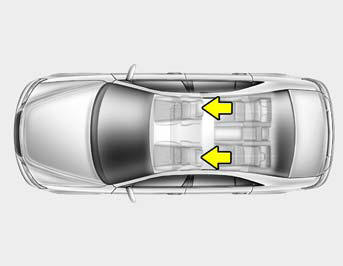Headrest

The driver's and front passenger's seats are equipped with a headrest for the occupant's safety and comfort.
The headrest not only provides comfort for the driver and front passenger, but also helps to protect the head and neck in the event of a collision.
WARNING:
o For maximum effectiveness in case of an accident, the headrest should be adjusted so the middle of the headrest is at the same height as the center of gravity of an occupant's head. Generally, the center of gravity of most people's head is similar with the height of the top of their eyes. Also, adjust the headrest as close to your head as possible. For this reason, the use of a cushion that holds the body away from the seatback is not recommended.
o Do not operate the vehicle with the headrests removed as severe injury to the occupants may occur in the event of an accident. Headrests may provide protection against neck injuries when properly adjusted.
o Do not adjust the headrest position of the driver's seat while the vehicle is in motion.
See also:
Gasolines for cleaner air
To help contribute to cleaner air, HYUNDAI recommends that you use gasolines
treated with detergent additives, which help prevent deposit formation in the engine.
These gasolines will help the eng ...
INTERIOR
The Elantra's interior has a masculine feel to it, thanks to the black dash
with metallic accents and gray-colored seat upholstery. The dash and center
stack have a simple layout with only a few b ...
Consumer information
This consumer information has been prepared
in accordance with regulations issued by the
National Highway Traffic Safety Administration
of the U.S. Department of Transportation. It
provides the pu ...


